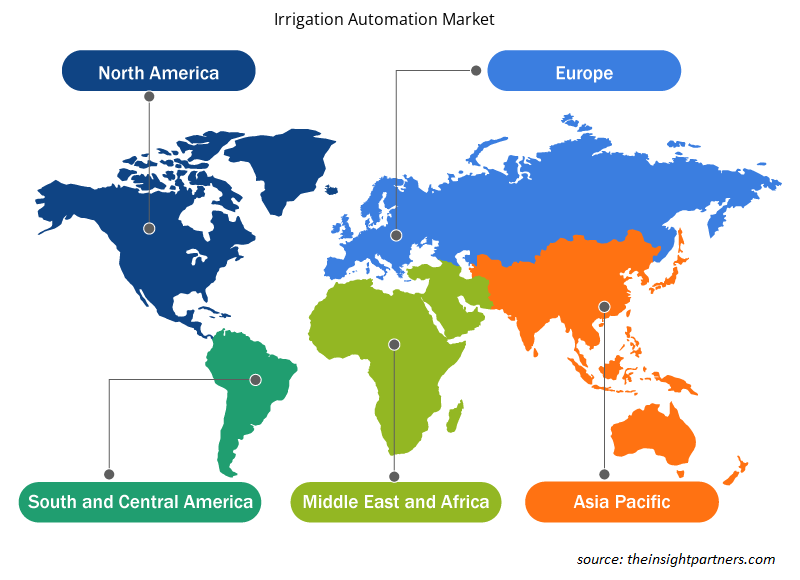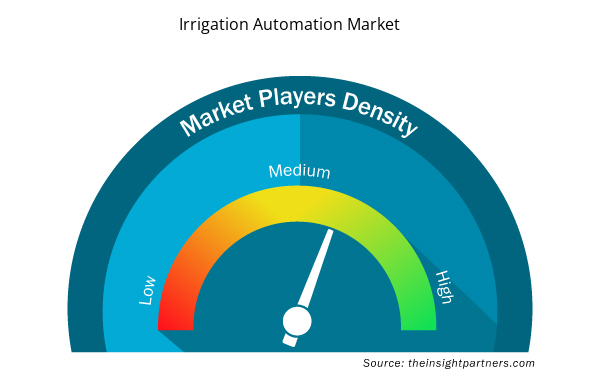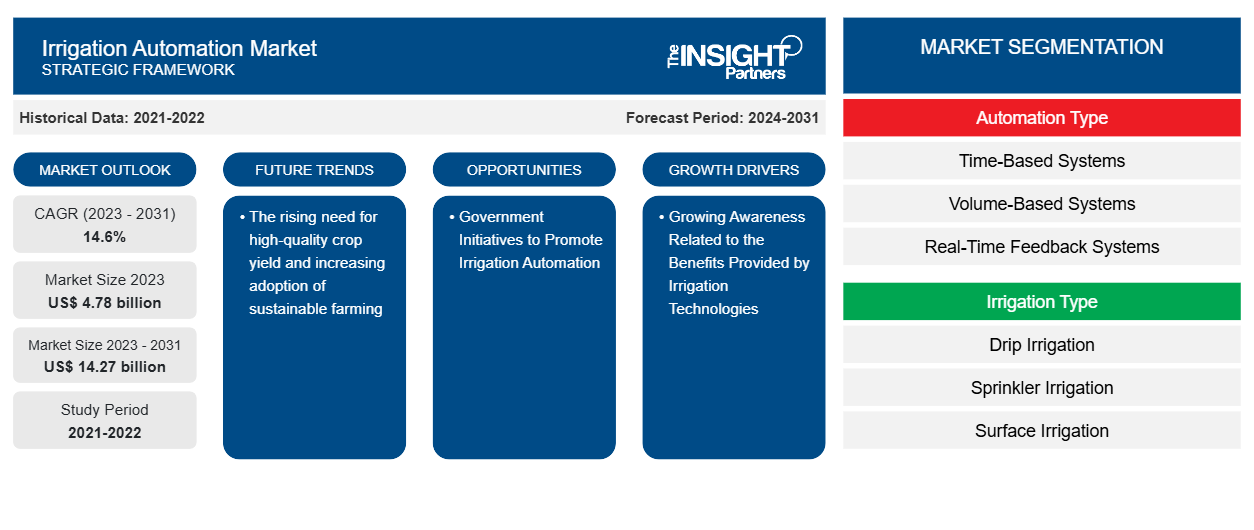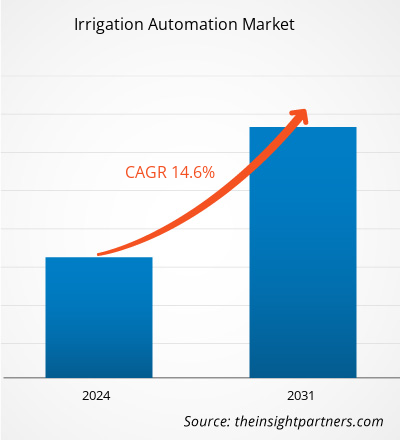灌漑自動化市場規模は、2023年の47億8,000万米ドルから2031年には142億7,000万米ドルに達すると予測されています。市場は2023年から2031年にかけて14.6%のCAGRを記録すると予想されています。高品質の作物収穫量に対するニーズの高まりと持続可能な農業の採用の増加は、灌漑自動化市場の重要なトレンドであり続けると思われます。
灌漑自動化市場分析
灌漑自動化市場は、灌漑技術がもたらすメリットに関する認識の高まりと、精密な農業機器や技術の受け入れにより、急速に成長しています。市場は、スマート農業技術に対する需要の高まりに牽引されて着実に拡大しています。さらに、技術の進歩と灌漑自動化を推進する政府の取り組みにより、市場の成長に有利な機会が生まれています。
灌漑自動化市場の概要
灌漑自動化では、機器や装置を使用してさまざまな灌漑システムを操作し、ベイからの水の流れを変更します。灌漑自動化には、センサー、バルブ、コントローラー、スプリンクラーなどの多数のハードウェアを組み合わせて、農業と非農業の両方の用途に使用される自動化システムを構築することが含まれます。灌漑自動化によって提供される時間の節約、コスト効率、リソースの最適化などの大きな利点が市場を牽引しています。
要件に合わせてレポートをカスタマイズする
このレポートの一部、国レベルの分析、Excelデータパックなど、あらゆるレポートを無料でカスタマイズできます。また、スタートアップや大学向けのお得なオファーや割引もご利用いただけます。
- このレポートの主要な市場動向を入手してください。この無料サンプルには、市場動向から見積もりや予測に至るまでのデータ分析が含まれます。
灌漑自動化市場の推進要因と機会
灌漑技術がもたらすメリットに関する認識の高まりが市場を牽引
農家は、高い人件費と電気代に関連する自動灌漑技術への認識が高まっています。灌漑技術は、節水、プロセスの自動化、コスト削減など、ユーザーに大きなメリットをもたらし、市場を牽引しています。これらのメリットにより農家の認識が高まり、灌漑技術の採用が急増しています。これらの技術は、農家が毎日の電力使用量を減らし、灌漑に費やす時間と労力を削減するのに役立ちます。さらに、農家は自動化によって農地への移動回数を減らすことができ、その結果、労働費を削減できました。自動灌漑システムを設置すると、正確な水量と灌漑時間を決定して農業の精度が向上します。この精度により、農家の作物の損失が減り、全体的な生産性が向上します。
灌漑自動化を推進する政府の取り組み - 灌漑自動化市場におけるチャンス
発展途上国の農家の大半は、時間のかかる従来の灌漑システム(表面灌漑)を採用しています。これにより、各国政府は灌漑の自動化を推進するための好ましい取り組みをしており、市場にチャンスが生まれることが期待されています。インド、中国、ブラジル、米国、フランス、その他のアフリカ諸国などの発展途上国の多くの政府は、灌漑システムの効率を高めるために、点滴およびスプリンクラーシステムの購入に助成金を提供しています。さらに、スプリンクラーおよび点滴灌漑システムの使用を奨励する厳格なポリシーは、農家が農場で技術的に開発されたシステムを採用するのに役立ちます。たとえば、農場灌漑装置(スプリンクラーおよび点滴灌漑システム)を取得して再設置するなどです。これらの要因は、予測期間中に市場に大きな成長の機会を生み出しています。
灌漑自動化市場レポートのセグメンテーション分析
灌漑自動化市場分析の導出に貢献した主要なセグメントは、自動化タイプ、灌漑タイプ、コンポーネント、システム、およびエンドユーザーです。
- 自動化の種類に基づいて、市場は時間ベースシステム、ボリュームベースシステム、リアルタイムフィードバックシステム、およびコンピューターベースの灌漑制御システムに分かれています。時間ベースシステムセグメントは、2023年に大きな市場シェアを占めました。
- 灌漑の種類に基づいて、市場は点滴灌漑、スプリンクラー灌漑、表面灌漑に分けられます。点滴灌漑セグメントは2023年に大きな市場シェアを占めました。
- コンポーネント別に見ると、市場はコントローラー、センサー、バルブ、スプリンクラー、その他に分類されます。コントローラーセグメントは2023年に大きな市場シェアを占めました。
- システムに基づいて、灌漑自動化市場は自動と半自動に分かれています。自動セグメントは2023年に大きな市場シェアを占めました。
- 最終用途別に見ると、市場は農業用と非農業用に分類されます。2023年には農業セグメントがより大きな市場シェアを占めました。
灌漑自動化市場シェアの地域別分析
灌漑自動化市場レポートの地理的範囲は、主に北米、アジア太平洋、ヨーロッパ、中東およびアフリカ、南米/中南米の 5 つの地域に分かれています。
収益面では、広大な農地と政府の好意的な支援により、アジア太平洋地域が灌漑自動化市場で最大のシェアを占めています。気候条件の急速な変化と廃棄物の削減の必要性の高まりにより、市場は近い将来に拡大すると予想されています。さらに、技術の進歩と高度な灌漑システムの開発により、予測期間中に市場が拡大しています。
灌漑自動化市場の地域別洞察
予測期間を通じて灌漑自動化市場に影響を与える地域的な傾向と要因は、Insight Partners のアナリストによって徹底的に説明されています。このセクションでは、北米、ヨーロッパ、アジア太平洋、中東、アフリカ、南米、中米にわたる灌漑自動化市場のセグメントと地理についても説明します。

- 灌漑自動化市場の地域別データを入手
灌漑自動化市場レポートの範囲
| レポート属性 | 詳細 |
|---|---|
| 2023年の市場規模 | 47億8000万米ドル |
| 2031年までの市場規模 | 142.7億米ドル |
| 世界のCAGR(2023年~2031年) | 14.6% |
| 履歴データ | 2021-2022 |
| 予測期間 | 2024-2031 |
| 対象セグメント | 自動化タイプ別
|
| 対象地域と国 | 北米
|
| 市場リーダーと主要企業プロフィール |
|
市場プレーヤーの密度:ビジネスダイナミクスへの影響を理解する
灌漑自動化市場は、消費者の嗜好の変化、技術の進歩、製品の利点に対する認識の高まりなどの要因により、エンドユーザーの需要が高まり、急速に成長しています。需要が高まるにつれて、企業は提供を拡大し、消費者のニーズを満たすために革新し、新たなトレンドを活用し、市場の成長をさらに促進しています。
市場プレーヤー密度とは、特定の市場または業界内で活動している企業または会社の分布を指します。これは、特定の市場スペースに、その市場規模または総市場価値に対してどれだけの競合相手 (市場プレーヤー) が存在するかを示します。
灌漑自動化市場で事業を展開している主要企業は次のとおりです。
- ガルコン株式会社
- ハンターインダストリーズ株式会社
- イリテック SpA
- ジェイン灌漑システム株式会社
- リンゼイコーポレーション
- ネルソン灌漑株式会社
免責事項:上記の企業は、特定の順序でランク付けされていません。

- 灌漑自動化市場のトップキープレーヤーの概要を入手
灌漑自動化市場のニュースと最近の動向
灌漑自動化市場は、主要な企業出版物、協会データ、データベースなどの一次調査と二次調査後の定性的および定量的データを収集することによって評価されます。以下は、灌漑自動化市場と戦略の動向の一覧です。
- 2024 年 3 月、ルビコン ウォーターはウズベキスタンとタジキスタンの国境における最新のプロジェクトを発表します。スイス協力事務所とブルー ピース イニシアチブの支援を受けたこの革新的なプロジェクトは、国境を越えた水管理における連携を促進するために、国境を越えた配水と測定に重点を置いています。灌漑用水管理の改善に加えて、ルビコンの技術は地下水管理、再涵養プログラム、環境フロー イニシアチブにおいてますます重要な役割を果たしており、重要な水資源と生態系の保全に貢献しています。(出典: ルビコン ウォーター、プレスリリース、2024 年)
灌漑自動化市場レポートの対象範囲と成果物
「灌漑自動化市場の規模と予測(2021〜2031年)」レポートでは、以下の分野をカバーする市場の詳細な分析を提供しています。
- 対象範囲に含まれるすべての主要市場セグメントの世界、地域、国レベルでの市場規模と予測
- 市場の動向(推進要因、制約、主要な機会など)
- 今後の主な動向
- 詳細なPEST/ポーターの5つの力とSWOT分析
- 主要な市場動向、主要プレーヤー、規制、最近の市場動向を網羅した世界および地域の市場分析
- 市場集中、ヒートマップ分析、主要プレーヤー、最近の動向を網羅した業界の状況と競争分析
- 詳細な企業プロフィール
- 過去2年間の分析、基準年、CAGRによる予測(7年間)
- PEST分析とSWOT分析
- 市場規模価値/数量 - 世界、地域、国
- 業界と競争環境
- Excel データセット


- HVAC Sensors Market
- Europe Tortilla Market
- Joint Pain Injection Market
- Energy Recovery Ventilator Market
- Pharmacovigilance and Drug Safety Software Market
- Adaptive Traffic Control System Market
- Legal Case Management Software Market
- Emergency Department Information System (EDIS) Market
- Industrial Valves Market
- Single-Use Negative Pressure Wound Therapy Devices Market

Report Coverage
Revenue forecast, Company Analysis, Industry landscape, Growth factors, and Trends

Segment Covered
This text is related
to segments covered.

Regional Scope
North America, Europe, Asia Pacific, Middle East & Africa, South & Central America

Country Scope
This text is related
to country scope.
よくある質問
The global irrigation automation market was estimated to be US$ 4.78 billion in 2023 and is expected to grow at a CAGR of 14.6% during the forecast period 2023 - 2031.
The growing awareness related to the benefits provided by irrigation technologies and the acceptance of precise agriculture instruments and techniques are the major factors that propel the global irrigation automation market.
The rising need for high-quality crop yield and increasing adoption of sustainable farming to play a significant role in the global irrigation automation market in the coming years.
The key players holding majority shares in the global irrigation automation market are Galcon Ltd., Hunter Industries Inc., Irritec S.p.A, Jain Irrigation Systems Ltd., and Lindsay Corporation.
The global irrigation automation market is expected to reach US$ 14.27 billion by 2031.
The incremental growth expected to be recorded for the global irrigation automation market during the forecast period is US$ 9.48 billion.
Trends and growth analysis reports related to Electronics and Semiconductor : READ MORE..
The Insight Partners performs research in 4 major stages: Data Collection & Secondary Research, Primary Research, Data Analysis and Data Triangulation & Final Review.
- Data Collection and Secondary Research:
As a market research and consulting firm operating from a decade, we have published and advised several client across the globe. First step for any study will start with an assessment of currently available data and insights from existing reports. Further, historical and current market information is collected from Investor Presentations, Annual Reports, SEC Filings, etc., and other information related to company’s performance and market positioning are gathered from Paid Databases (Factiva, Hoovers, and Reuters) and various other publications available in public domain.
Several associations trade associates, technical forums, institutes, societies and organization are accessed to gain technical as well as market related insights through their publications such as research papers, blogs and press releases related to the studies are referred to get cues about the market. Further, white papers, journals, magazines, and other news articles published in last 3 years are scrutinized and analyzed to understand the current market trends.
- Primary Research:
The primarily interview analysis comprise of data obtained from industry participants interview and answers to survey questions gathered by in-house primary team.
For primary research, interviews are conducted with industry experts/CEOs/Marketing Managers/VPs/Subject Matter Experts from both demand and supply side to get a 360-degree view of the market. The primary team conducts several interviews based on the complexity of the markets to understand the various market trends and dynamics which makes research more credible and precise.
A typical research interview fulfils the following functions:
- Provides first-hand information on the market size, market trends, growth trends, competitive landscape, and outlook
- Validates and strengthens in-house secondary research findings
- Develops the analysis team’s expertise and market understanding
Primary research involves email interactions and telephone interviews for each market, category, segment, and sub-segment across geographies. The participants who typically take part in such a process include, but are not limited to:
- Industry participants: VPs, business development managers, market intelligence managers and national sales managers
- Outside experts: Valuation experts, research analysts and key opinion leaders specializing in the electronics and semiconductor industry.
Below is the breakup of our primary respondents by company, designation, and region:

Once we receive the confirmation from primary research sources or primary respondents, we finalize the base year market estimation and forecast the data as per the macroeconomic and microeconomic factors assessed during data collection.
- Data Analysis:
Once data is validated through both secondary as well as primary respondents, we finalize the market estimations by hypothesis formulation and factor analysis at regional and country level.
- Macro-Economic Factor Analysis:
We analyse macroeconomic indicators such the gross domestic product (GDP), increase in the demand for goods and services across industries, technological advancement, regional economic growth, governmental policies, the influence of COVID-19, PEST analysis, and other aspects. This analysis aids in setting benchmarks for various nations/regions and approximating market splits. Additionally, the general trend of the aforementioned components aid in determining the market's development possibilities.
- Country Level Data:
Various factors that are especially aligned to the country are taken into account to determine the market size for a certain area and country, including the presence of vendors, such as headquarters and offices, the country's GDP, demand patterns, and industry growth. To comprehend the market dynamics for the nation, a number of growth variables, inhibitors, application areas, and current market trends are researched. The aforementioned elements aid in determining the country's overall market's growth potential.
- Company Profile:
The “Table of Contents” is formulated by listing and analyzing more than 25 - 30 companies operating in the market ecosystem across geographies. However, we profile only 10 companies as a standard practice in our syndicate reports. These 10 companies comprise leading, emerging, and regional players. Nonetheless, our analysis is not restricted to the 10 listed companies, we also analyze other companies present in the market to develop a holistic view and understand the prevailing trends. The “Company Profiles” section in the report covers key facts, business description, products & services, financial information, SWOT analysis, and key developments. The financial information presented is extracted from the annual reports and official documents of the publicly listed companies. Upon collecting the information for the sections of respective companies, we verify them via various primary sources and then compile the data in respective company profiles. The company level information helps us in deriving the base number as well as in forecasting the market size.
- Developing Base Number:
Aggregation of sales statistics (2020-2022) and macro-economic factor, and other secondary and primary research insights are utilized to arrive at base number and related market shares for 2022. The data gaps are identified in this step and relevant market data is analyzed, collected from paid primary interviews or databases. On finalizing the base year market size, forecasts are developed on the basis of macro-economic, industry and market growth factors and company level analysis.
- Data Triangulation and Final Review:
The market findings and base year market size calculations are validated from supply as well as demand side. Demand side validations are based on macro-economic factor analysis and benchmarks for respective regions and countries. In case of supply side validations, revenues of major companies are estimated (in case not available) based on industry benchmark, approximate number of employees, product portfolio, and primary interviews revenues are gathered. Further revenue from target product/service segment is assessed to avoid overshooting of market statistics. In case of heavy deviations between supply and demand side values, all thes steps are repeated to achieve synchronization.
We follow an iterative model, wherein we share our research findings with Subject Matter Experts (SME’s) and Key Opinion Leaders (KOLs) until consensus view of the market is not formulated – this model negates any drastic deviation in the opinions of experts. Only validated and universally acceptable research findings are quoted in our reports.
We have important check points that we use to validate our research findings – which we call – data triangulation, where we validate the information, we generate from secondary sources with primary interviews and then we re-validate with our internal data bases and Subject matter experts. This comprehensive model enables us to deliver high quality, reliable data in shortest possible time.


 このレポートの無料サンプルを入手する
このレポートの無料サンプルを入手する